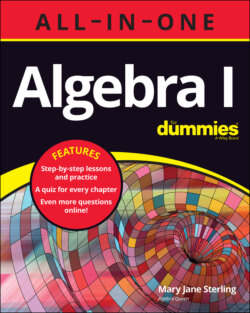Читать книгу Algebra I All-in-One For Dummies - Mary Jane Sterling, Mary Sterling Jane - Страница 69
Working with Factorial
ОглавлениеThe nonbinary operation called factorial is important in problems involving probability, counting items, and, of course, is a basic function used in algebra. When you see n!, you know to take the number n and multiply it by every natural number smaller than it is:
The number n must be a whole number. This means that 1! is rather redundant. There’s no natural number smaller, so . And then there’s 0!. There’s no natural number smaller than 0; in fact, 0 isn’t a natural number itself! By definition, . How can that be? Well, mathematicians decided it is so. And it wasn’t arbitrary or a flip-of-the-coin. By assigning 0! the value 1, it makes all sorts of formulas for counting and other applications work consistently.
A particular challenge when working with factorials is to reduce fractions containing those functions. Basically, you find the common factors in the factorials in the numerator and denominator, eliminate them, and determine what’s left.
Q. What is ?
A. If these were just the two numbers 4 and 3, you would either leave it as is, because 4 and 3 don’t have any common factors other than 1, or you would write this as a mixed number. It’s different with factorials. Rewrite the fraction after expanding the factorial values.
Q. What is ?
A. Write out the factorials and reduce the fraction.
Q. What is ?
A. The value of is defined to be 1. This is by design/definition.
Q. What is ?
A. “Yikes!”, you say. I have to write out the product of all the numbers from 100 down to 1 and then from 97 down to 1? “No,” is the answer. You can take a shortcut. In the numerator, instead of writing from 97 down to 1, just use 97!. Here’s how it works:
32
33
34
